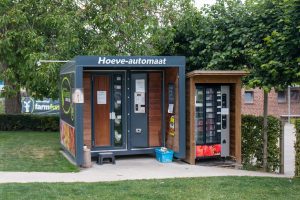“Urbanisation is a big problem in Flanders!”
Bart Vanderstraeten (38) runs a mixed farm with his wife Marijke (31) in Merchtem, a village just outside Brussels (Belgium). In addition to dairy cattle and arable farming, there are also farm camps for children and team activities for companies. Various home-grown crops are sold in the farm shop, when it is closed customers can still go to the vending machines on the street side.
Bart is the 4th generation at the “Het Koeweidehof”, as the farm was baptized. Bart’s parents, who are still active on the farm, had an extensive herd of Belgian white-blue beef cattle, various arable crops and in the winter ground chicory was cultivated. Bart, however, took the step to dairy cattle. “Dairy cattle provides a fairly high balance per hectare,” says Bart. “Arable crops are seasonal and are more volatile on balance per hectare. The investment in the barn and equipment was not small, but if the bill is correct it can be justified.”
Starting a new dairy farm is no small task. Luckily Marijke already had experience with milking at home and her mother came by regularly to help Bart learn the tricks of the trade.
Milking with the robot
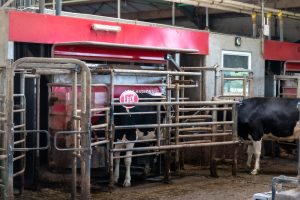 Bart and Marijke immediately opted for a robot during the construction of the new barn. In June 2012 the construction of the barn started, the first cows arrived in November. In 2015, after the end of the milk quota, the herd expanded to about 120 heads and a second robot was added, again a Lely Astronaut A4. “In the beginning I went to work full time,” Bart explains, “difficult to combine with traditional morning and evening milking. We started a new farm, so we were able to control everything. We had no experience with traditional milking, so we were able to compare all the pros and cons in an objective way.” For Bart, a big advantage of robotic milking is the continuous data that is collected, not only during milking but also during the day, real time, when walking around or ruminating. In traditional milking you look at the udder, while the robot displays a mass of statistics. “Before you effectively diagnose mastitis, a lot of other symptoms have already passed that you may not have noticed, such as reduced cow activity, reduced ruminant activity, mild fever and so on. The robot measures this much faster, so I can seclude the cow and treat her with light medication instead of antibiotics. I only want to use those when there’s really no other way. The cow is also milked 4 times a day instead of 2 or 3 times to relieve the pressure on the udder. In this way I prevent the cow from becoming too sick and limit the loss of milk. The loss of milk due to mastitis can quickly reach 750 litres!” The peace and quiet in the barn of Bart and Marijke is striking. “I’m convinced that I know my animals better than someone who milks traditionally, the hours they spend in the parlour, I spend between my ladies in the barn.”
Bart and Marijke immediately opted for a robot during the construction of the new barn. In June 2012 the construction of the barn started, the first cows arrived in November. In 2015, after the end of the milk quota, the herd expanded to about 120 heads and a second robot was added, again a Lely Astronaut A4. “In the beginning I went to work full time,” Bart explains, “difficult to combine with traditional morning and evening milking. We started a new farm, so we were able to control everything. We had no experience with traditional milking, so we were able to compare all the pros and cons in an objective way.” For Bart, a big advantage of robotic milking is the continuous data that is collected, not only during milking but also during the day, real time, when walking around or ruminating. In traditional milking you look at the udder, while the robot displays a mass of statistics. “Before you effectively diagnose mastitis, a lot of other symptoms have already passed that you may not have noticed, such as reduced cow activity, reduced ruminant activity, mild fever and so on. The robot measures this much faster, so I can seclude the cow and treat her with light medication instead of antibiotics. I only want to use those when there’s really no other way. The cow is also milked 4 times a day instead of 2 or 3 times to relieve the pressure on the udder. In this way I prevent the cow from becoming too sick and limit the loss of milk. The loss of milk due to mastitis can quickly reach 750 litres!” The peace and quiet in the barn of Bart and Marijke is striking. “I’m convinced that I know my animals better than someone who milks traditionally, the hours they spend in the parlour, I spend between my ladies in the barn.”
Bart and Marijke’s cows give between 34 and 36 litres per day on average. They are top athletes with whom nothing can go wrong. By regularly checking out the animals and with the statistics of the robots, the animals can be followed up very quickly. “You can’t let a crippled cow walk around for a week! They go directly into the hoof trimming box so I can take care of them as soon as possible. Running on a limp quickly costs 1 or 2 litres milk per day. With a quick follow up, I can see results the day after”, Bart explains.
Feeding with the robot
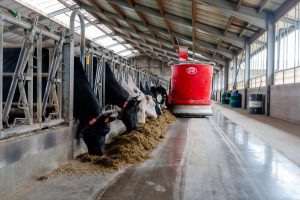 In addition to the Lely milking robots, the Dutch manufacturer also supplied a complete feeding robot. “With the expansion of the herd, the feed mixer became too small. I had to fill 5 wagons and was spending 2.5 hours a day just feeding all the animals on the farm. I looked at a few tracks, such as a new combination for myself, but also a larger self-propelled feed mixer to be used by others as a form of agricultural contracting,” Bart remembers. “At that time, I could still count on external help, but when that help fell away and due to lack of interest from other farmers, I also put aside the idea of contract feeding. During a chat with Lely, the concept of robot feeding came up. After some calculations, I went for that solution.” Automatic feeding not only gives Bart satisfied cows, but also extra time. Twice a week the feed kitchen has to be replenished, the rest of the time the robot will take care of the feeding itself. In that way, there’s always fresh food in front of the fence.
In addition to the Lely milking robots, the Dutch manufacturer also supplied a complete feeding robot. “With the expansion of the herd, the feed mixer became too small. I had to fill 5 wagons and was spending 2.5 hours a day just feeding all the animals on the farm. I looked at a few tracks, such as a new combination for myself, but also a larger self-propelled feed mixer to be used by others as a form of agricultural contracting,” Bart remembers. “At that time, I could still count on external help, but when that help fell away and due to lack of interest from other farmers, I also put aside the idea of contract feeding. During a chat with Lely, the concept of robot feeding came up. After some calculations, I went for that solution.” Automatic feeding not only gives Bart satisfied cows, but also extra time. Twice a week the feed kitchen has to be replenished, the rest of the time the robot will take care of the feeding itself. In that way, there’s always fresh food in front of the fence.
Flax as a new arable crop
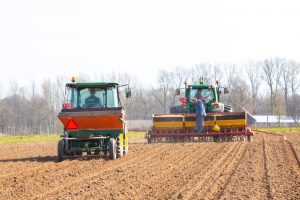 The Koeweidehof also has an extensive arable farming branch. Approximately 160 hectares of land are cultivated, half of which is used for roughage production for dairy and beef cattle. The other half is used for, among other things, potatoes, onions, cereals, corn and, since 2019, also flax. “Urbanisation in Flanders is making agricultural land scarce. In addition, land can be bought by anyone. For example, many plots of land are bought by people outside the sector, often occasional purchases as an investment. Such people can pay considerably more than we can as young farmers. We then have to rent the land again at often high prices. It is then crucial to look for crops that make the high rents justifiable” Marijke’s parents also have an arable farming branch on their farm. In 2016, a large potato storage shed was built so that the young farmer himself could also start storing potatoes in this shed. The intention is that in the future the company would evolve to 2 locations. Dairy cattle at the Koeweidehof, the arable farm in Londerzeel, 14 kilometres away. When Bart’s parents stop farming, the beef cattle and the ground chicory will probably go out.
The Koeweidehof also has an extensive arable farming branch. Approximately 160 hectares of land are cultivated, half of which is used for roughage production for dairy and beef cattle. The other half is used for, among other things, potatoes, onions, cereals, corn and, since 2019, also flax. “Urbanisation in Flanders is making agricultural land scarce. In addition, land can be bought by anyone. For example, many plots of land are bought by people outside the sector, often occasional purchases as an investment. Such people can pay considerably more than we can as young farmers. We then have to rent the land again at often high prices. It is then crucial to look for crops that make the high rents justifiable” Marijke’s parents also have an arable farming branch on their farm. In 2016, a large potato storage shed was built so that the young farmer himself could also start storing potatoes in this shed. The intention is that in the future the company would evolve to 2 locations. Dairy cattle at the Koeweidehof, the arable farm in Londerzeel, 14 kilometres away. When Bart’s parents stop farming, the beef cattle and the ground chicory will probably go out.
The expansion of Brussels and the surrounding villages is putting increasing pressure on agricultural land. For the (young) farmers, their land is an economic fact, but the citizens see the fields as an opportunity for relaxation. Buying up land by citizens to take it out of agriculture, for example by turning it into gardens, also causes rising prices. “Within Europe, every region has its problems or peculiarities. With us, it’s urbanisation and its consequences. I hope that the competent people within the EU will really take this into account in the future”, Bart still sighs.
Biogas
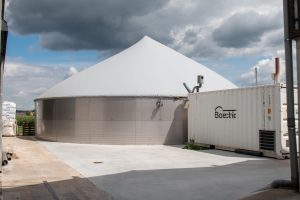 From the beginning Bart made the choice to extract biogas from his manure. Because the company was started from 0, the installation could be optimally integrated. For example, the floor of the barn has been adapted to remove the manure as quickly as possible by means of a slurry scraper. “The milking and feeding robots demand their share of power. The price of electricity has risen by more than 70% in just a few years; for a company like mine that would mean an enormous increase in the cost per litre of milk produced. By fermenting the manure in a Biolectric pocket digester, I create my own green energy for my company” The first small digester was built together with the stable in 2012. Last winter it was replaced by a slightly larger 22 kW installation. The cow manure is transported via a scraper into a small pit where it is pumped into the digester. The fermented manure is pumped from there to the manure storage. The collected gas is converted into electricity by an engine. Bart uses the digestate as a fertilizer on his grassland and fields.
From the beginning Bart made the choice to extract biogas from his manure. Because the company was started from 0, the installation could be optimally integrated. For example, the floor of the barn has been adapted to remove the manure as quickly as possible by means of a slurry scraper. “The milking and feeding robots demand their share of power. The price of electricity has risen by more than 70% in just a few years; for a company like mine that would mean an enormous increase in the cost per litre of milk produced. By fermenting the manure in a Biolectric pocket digester, I create my own green energy for my company” The first small digester was built together with the stable in 2012. Last winter it was replaced by a slightly larger 22 kW installation. The cow manure is transported via a scraper into a small pit where it is pumped into the digester. The fermented manure is pumped from there to the manure storage. The collected gas is converted into electricity by an engine. Bart uses the digestate as a fertilizer on his grassland and fields.
On holidays with young farmers
Bart and Marijke got to know each other during a trip of the Groene Kring, a Flemish association for young farmers in which they were both active. “While traveling in Germany, we visited John Deere’s factory, among other things,” remembers Bart. “I had just graduated and I didn’t think about becoming a farmer at all. I started working at the Aveve Group where I sold crop protection products, among other things. When my parents started talking about quitting the farm, it began to itch…. It would have been a shame to lose the work of my parents and grandparents.”
Bart and Marijke both followed a higher agricultural education. Marijke’s background at home made the choice for dairy cattle easier. The dairy cattle also made it easier for her to find her place on the new farm. She also introduced the farm camps for children and team building FarmFun for companies at the Koeweidehof.
Difference on the rules between EU and Flanders
The impact of Europe’s regulations on a company like Bart’s cannot be underestimated. In addition, Belgian and Flemish rules also apply. For example, when it comes to greening, the different rules have to be taken into account. “We have a mixed farm, so we automatically have enough different crops. This is different for farmers with only dairy cattle and the associated maize and grassland, who then have to look for a third crop. The differences in rules often cause confusion. For example, the descriptions of “catch crop” are different for the local Flemish legislator than for the EU. The VLM (Vlaamse LandMaatschappij) doesn’t allow to have leguminous plants in the mixture, whereas the EU rules allow this. This makes it extra difficult for us!”
|
Bart & Marijke jointly operate the Koeweidehof, a mixed farm in Merchtem (Belgium), just outside Brussels. In November 20012 they started a new dairy farm. For both milking and feeding they opted resolutely for robots. From the manure of the cows, biogas is made which is converted into electricity for the farm.
You can follow the Koeweidehof on Facebook.
|
Text: Kim Schoukens
Images: Antoon Vanderstraeten
This article appeared in Farmers of Europe Magazine nbr. 1.


